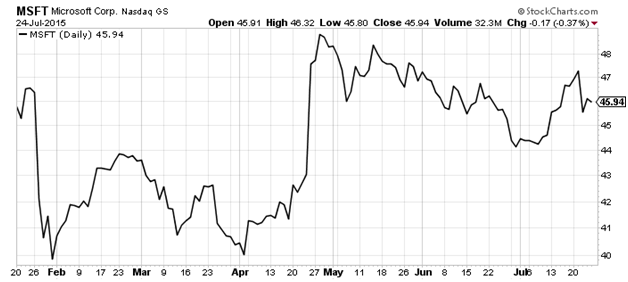I could ramble on for several paragraphs about what a great stock Microsoft (NASDAQ: MSFT) is.
I could talk about its 2.7% dividend yield or how it’s one of the most shareholder-friendly companies on Earth.
But I won’t bother, because there’s a good chance you know that already.
Instead, I’ll show you how to make a 2.2% return on Microsoft – while naming your own purchase price.
Microsoft stock is trading for roughly $46.
I would like to buy it a little cheaper – say, for $44.
I could simply place a limit order to buy the tech behemoth at $44.
Of course, in my mind, that would be a silly choice.
Instead, you could sell a few puts at the $44 strike and collect some premium that will allow you to lower your cost basis in the stock.

The Strategy
Selling a put obligates you to buy shares of a stock or ETF at your chosen strike price if the put option is assigned. Remember, we are comfortable owning the stock at $44. Our intent is to buy the stock, at the aforementioned price, if the put is assigned.
Make sure you keep enough cash on hand in your account if and when the put is assigned and you are issued shares at your strike price.
Again, the premium that you collected from selling the put will lower the cost basis. If the stock doesn’t push below the chosen strike price at expiration – in this case $44 – you keep the premium for selling the put.
The Trade
Sell to open Microsoft (MSFT) October 44 puts for around $0.96.

Selling a put at the $44 strike for $0.96 means you immediately lower your basis by that amount. Your cost basis is now $43.04, or roughly 6.4% lower than Microsoft’s current share price.
If the stock pushes below the $44 strike price at expiration, you are obligated to buy 100 Microsoft shares for $44 a share. Buying 100 shares at $44 represents a potential obligation of $4,400.
If the markets remain unchanged and Microsoft trades above $44 at October expiration, you won’t have to buy the stock. You keep the $96 premium. That’s a 2.2% return for simply agreeing to buy Microsoft at your chosen price, in this case $44.
If Microsoft trades below $44 at October expiration, you’ll still keep the $96. But you’ll have to buy Microsoft at $44 per share. You’ll own Microsoft at $43.04 (the $44 strike minus the $0.96-per-share premium).
Here’s how that scenario works out for each option contract you sell…
Initial income from sold put premium: $96.
Purchase 100 shares of MSFT at $44: $4,400.
Total outlay: $4,304 ($4,400 – $96).
The price ($4,304) is approximately 6.4% below Microsoft’s current market price. This gives you very good downside protection. More importantly, it allows you to purchase the stock for a nice discount, and each time you sell premium the cost of the stock becomes cheaper and cheaper.
Potential Risk
The potential risk is that Microsoft plummets from $46 to theoretically $0. Since you sold the $44 strike, your potential loss is $4,400. But let’s be realists. Do we really think Microsoft is going to push to $0 by October expiration in less than 80 days?
Moreover, the worst-case scenario in my mind is if the stock suffers from a news-driven event like an earnings setback. In this case, yes, the stock could lose 10%, 20% or possibly 30%, but even a 30% decline in less than 80 days would be a statistical anomaly.
However, it is exactly for this reason why I only sell puts on companies with sound fundamentals. That means mostly blue chip stocks that I don’t mind owning in my portfolio, like Microsoft.
People get into lots of trouble when they sell puts on companies that are highly volatile. Highly volatile companies – as seen through an increase in implied volatility – contain more risk, so you can sell puts for higher prices. But don’t let the temptation get to you. Stay away! Seeking out juicy mega-premiums will eventually lead to disaster. Stick with sound companies and avoid the high-flyers.
— Andy Crowder
Source: Wyatt Investment Research

